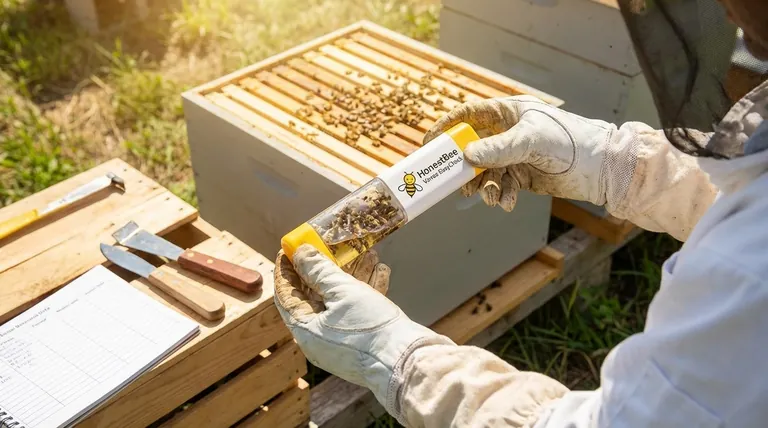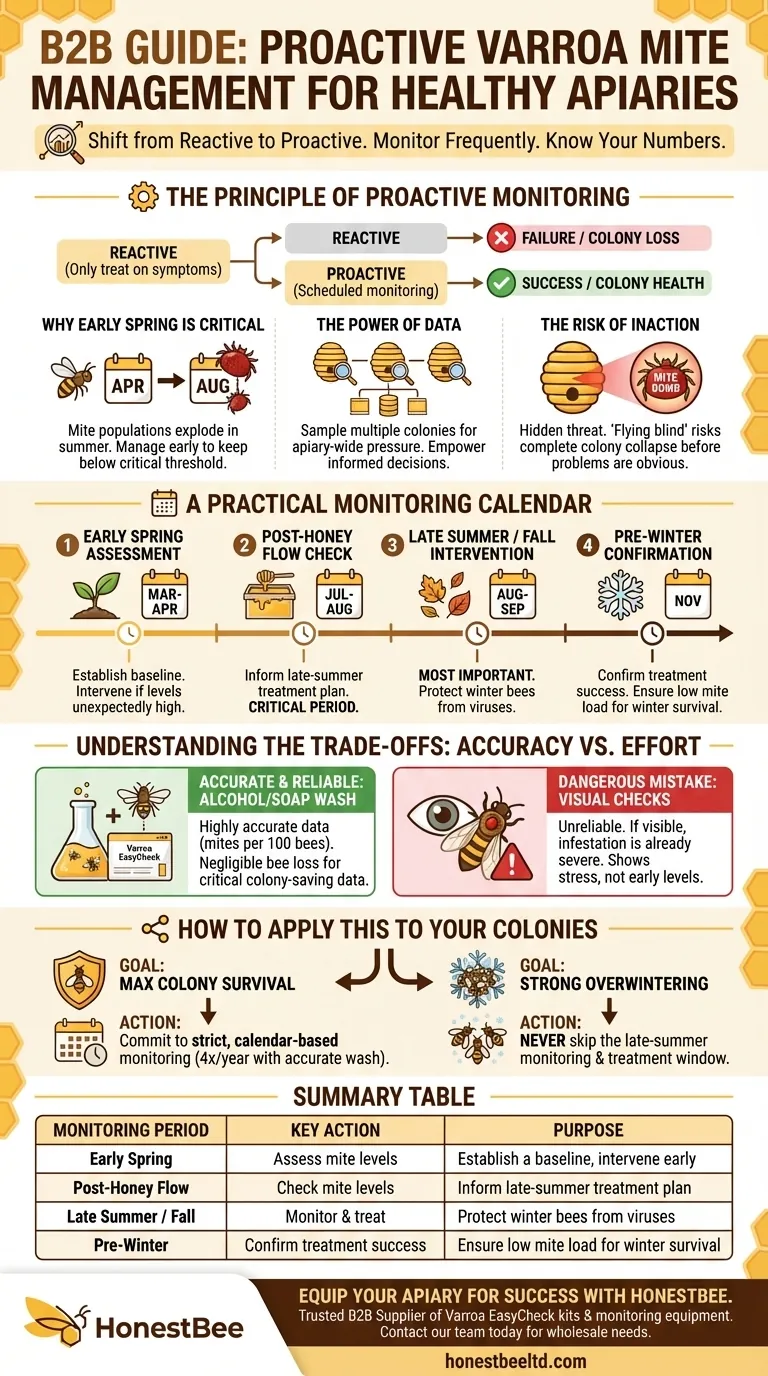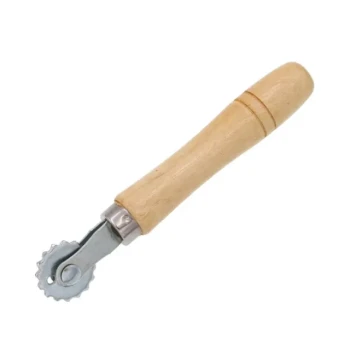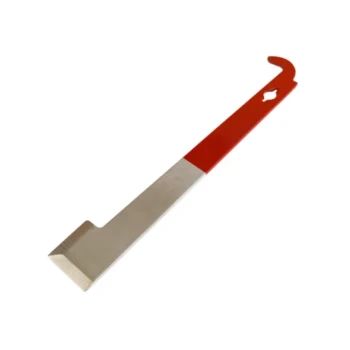The most critical advice for managing Varroa mites is to shift from a reactive to a proactive strategy. This involves frequently monitoring mite levels throughout the year, especially early in the spring, to prevent populations from reaching destructive levels in late summer. Effective management is entirely dependent on knowing your numbers.
The core principle is that you cannot manage what you do not measure. Simply looking for mites on bees is an unreliable indicator; by the time an infestation is visually obvious, the colony is often in critical danger. A structured, data-driven monitoring plan is the only way to ensure colony health and survival.

The Principle of Proactive Monitoring
Varroa destructor is the single greatest threat to honey bee health. A reactive approach, where you only treat when bees show symptoms, is a recipe for failure. A proactive monitoring schedule allows you to stay ahead of the mite's exponential growth curve.
Why Early Spring is Critical
Mite populations build slowly in the spring and then explode during the summer brood-rearing season. A small, manageable mite load in April can become a colony-killing infestation by August.
By monitoring and managing mites early, you significantly lower the starting population, keeping their numbers below the critical damage threshold for the entire season.
The Power of Data
Monitoring isn't just about one hive; it's about understanding the overall mite pressure in your apiary.
Sampling multiple colonies provides a more accurate picture of the situation. This data empowers you to make informed decisions about when, or even if, treatment is necessary.
The Risk of Inaction
Failing to consistently monitor mite levels is the most common reason for unexpected colony loss. A colony can appear strong in mid-summer while a hidden "mite bomb" is developing within the capped brood.
Without monitoring, you are essentially flying blind, risking the complete collapse of your colonies before you even realize there is a problem.
A Practical Monitoring Calendar
A consistent schedule removes the guesswork from Varroa management. Experts advise monitoring at least three to four key times during the beekeeping season.
Early Spring Assessment
Your first check should occur as the colony begins to build up its population. This establishes a baseline for the year and is your first opportunity to intervene if levels are unexpectedly high.
Post-Honey Flow Check
After you have removed your main honey supers, it's an ideal time to check mite levels again. This check informs your treatment plan for late summer, the most critical period for mite control.
Late Summer / Fall Intervention
This is the most important monitoring and treatment window. Mites must be controlled now to ensure the bees being raised for the winter are healthy and free from viruses that Varroa transmits.
Pre-Winter Confirmation
A final check in late autumn or early winter, often in November, confirms the success of your fall treatment. This assessment ensures the colony is entering its winter cluster with a very low mite load, maximizing its chance of survival.
Understanding the Trade-offs
Effective Varroa management requires an investment of time and a clear understanding of the limitations of certain methods.
Accuracy vs. Effort
Methods like an alcohol wash or soap wash provide highly accurate and reliable data on your mite infestation levels. Tools like the Varroa EasyCheck are designed specifically for this purpose.
While these methods require sacrificing a sample of approximately 300 bees, this is a negligible loss for a healthy colony and provides the critical data needed to save the entire hive.
The Limitation of Visual Checks
Relying solely on visual inspection is a common and dangerous mistake. If you can easily see mites on the backs of adult bees, the infestation level is already extremely high and the colony is under severe stress.
Visual checks are useful for spotting secondary symptoms like Deformed Wing Virus (DWV), but they are not a substitute for a quantitative test that measures mites per 100 bees.
How to Apply This to Your Colonies
Your management strategy should be directly tied to your beekeeping goals. Use your monitoring data to make the right choice for the health of your bees.
- If your primary focus is maximum colony survival: Commit to a strict, calendar-based monitoring schedule using an accurate method like an alcohol wash at least four times a year.
- If your primary focus is ensuring a strong overwintering population: Never skip the late-summer monitoring and treatment window, as this is the single most important factor for winter success.
Ultimately, consistent monitoring transforms you from a passive bee-haver into an effective bee-keeper, putting you in control of your colonies' health and destiny.
Summary Table:
| Monitoring Period | Key Action | Purpose |
|---|---|---|
| Early Spring | Assess mite levels | Establish a baseline, intervene early |
| Post-Honey Flow | Check mite levels | Inform late-summer treatment plan |
| Late Summer / Fall | Monitor & treat | Protect winter bees from viruses |
| Pre-Winter | Confirm treatment success | Ensure low mite load for winter survival |
Equip your apiary for success with HONESTBEE. Managing Varroa mites effectively requires reliable tools and a proactive strategy. As a trusted supplier for commercial apiaries and beekeeping equipment distributors, we provide the durable, wholesale-focused supplies you need—from Varroa EasyCheck kits to essential monitoring equipment. Don't let mite levels threaten your colonies or your business. Contact our team today to discuss your wholesale needs and ensure your beekeeping operation thrives year-round.
Visual Guide

Related Products
- Varroa Easy Check Mite Tester Kit Counter Alcohol Wash Jar
- Adjustable Formic and Acetic Acid Dispenser for Bee Mite Treatment
- Professional Bee Smoker with Elongated Spout and Durable Bellows for Beekeeping
- Economy Galvanized Beekeeping Honey Bee Smoker for Wholesale
- HONESTBEE Advanced Ergonomic Stainless Steel Hive Tool for Beekeeping
People Also Ask
- What is the most reliable method for assessing Varroa mite infestations? Master Proactive Hive Management
- What are the steps to perform an alcohol wash test after collecting the bees? A Guide to Accurate Varroa Mite Counting
- What is the Varroa EasyCheck used for? Accurate Mite Monitoring for Healthy Hives
- Why is an alcohol wash preferred over powdered sugar rolls? For Accurate Varroa Mite Management
- What are some popular methods to measure Varroa mite load in beehives? Compare Accuracy & Bee Safety



















